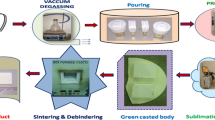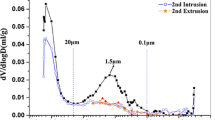Abstract
A pressure infiltration apparatus was used to fabricate textile ceramic matrix composites using sol-gel processing with added solid particles. A parabolic rate kinetics model for the infiltration process has been developed and experimentally verified. Darcy's law and a global permeability of the whole material system were adopted in the model. Experiments were conducted using both a 3-d angle interlock and a 2-d woven carbon fibre preform, and a silica sol containing silica particles of submicrometre sizes. The thickness of the particle compaction layer inside the 3-d preform is proportional to the square root of the processing time. The total infiltration time was inversely proportional to the constant processing pressure and increased significantly with reducing the solid particle size by a factor of two. The addition of a non-ionic surfactant reduced the surface energy which resulted in higher composite green density values of up to 90%. Sol-gel processing with added solid particles proved to be a viable method to fabricate textile ceramic matrix composites with a higher density and improved properties.
Similar content being viewed by others
References
H. K. Liu and A. Parvizi-Majidi, Ceram. Engng Sci. Proc. 13 (1992) 642.
J. A. Cornie, Y. M. Chiang, D. R. Uhlmann, A. Mortensen and J. M. Collins, Amer. Ceram. Soc. Bull. 65 (1986) 293.
F. F. Lange and K. T. Miller, ibid. 66 (1987) 1498.
S. C. Danforth and F. G. R. Gauthier, “Ceramic Transactions, Vol 1, Part B, Ceramic Powder Science”, (American Ceramic Society, Westerville OH, 1988) 709.
S. C. Danforth and M. Velazquez, in “Surface and Colloid Science in Computer Technology” ed. by K. L. Mittal, (Plenum, New York, 1987) p. 86.
B. R. Marple and D. J. Green, J. Amer. Ceram. Soc. 73 (1990) 3611.
S. G. Advani, “Effective In-plane Permeability of Multilayered RTM Preforms,” Centre for Composite Materials Report, University of Delaware (1992).
G. W. Scherer J. Non-Cryst. Solids 113 (1989) 107.
Idem. ibid. 113 (1989) 119.
S. J. Lukasiewicz and J. S. Reed, J. Amer. Ceram. Soc. 71 (1988) 1008.
H. K. Liu and A. Parvizi-Majidi, “Better Ceramics through Chemistry V, Materials Research Society Proceedings Vol. 271”, ed. by C. J. Brinker (Materials Research Society, Pittsburgh, 1992) 601.
F. A. L. Dullien, “Porous Media: Fluid Transport and Pore Structure”, (Academic Press, NewYork, 1979) Ch. 4.
A. C. Loos, M. H. Weideman, E. R. Long Jr., D. E. Kranbuehl, P. J. Kinsley and S. M. Hart, Presented at First NASA Advanced Composites Technology Conference, Seattle, Washington 29 October–1 November 1990. NASA conference publication 3104, Part 2 (NASA, Langley, 1991) p. 425.
Author information
Authors and Affiliations
Rights and permissions
About this article
Cite this article
Liu, HK. Investigation on the pressure infiltration of sol-gel processed textile ceramic matrix composites. JOURNAL OF MATERIALS SCIENCE 31, 5093–5099 (1996). https://doi.org/10.1007/BF00355910
Received:
Accepted:
Published:
Issue Date:
DOI: https://doi.org/10.1007/BF00355910




